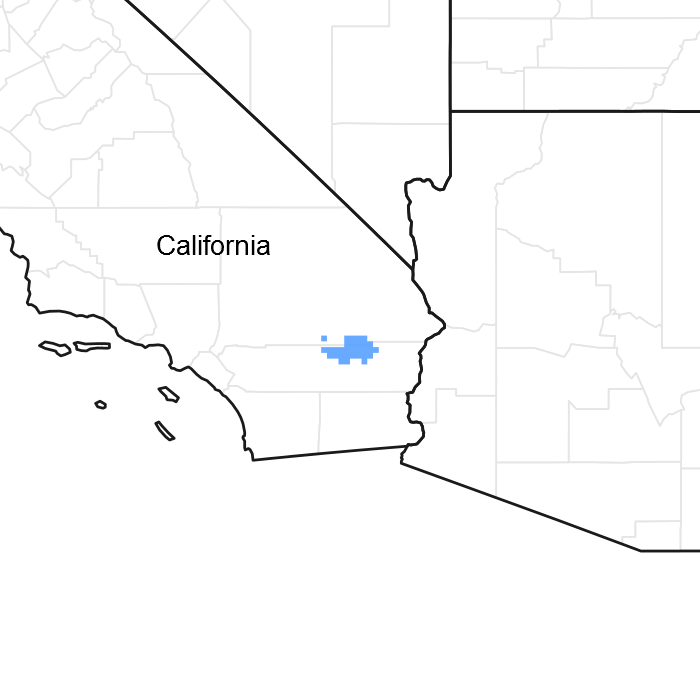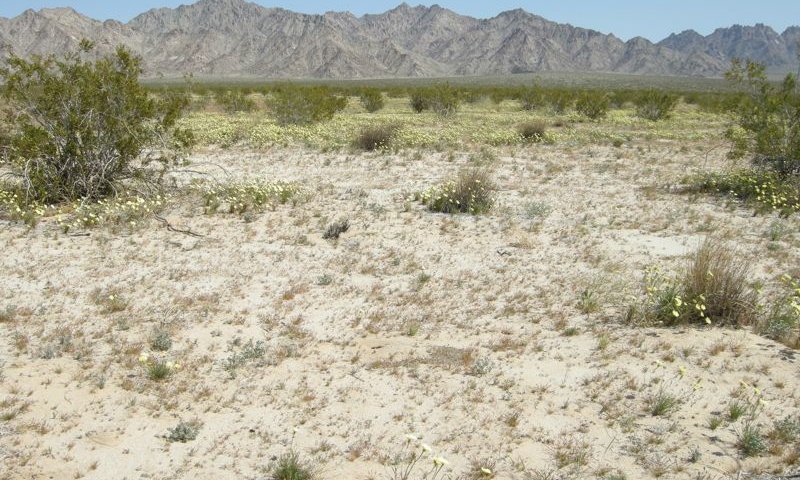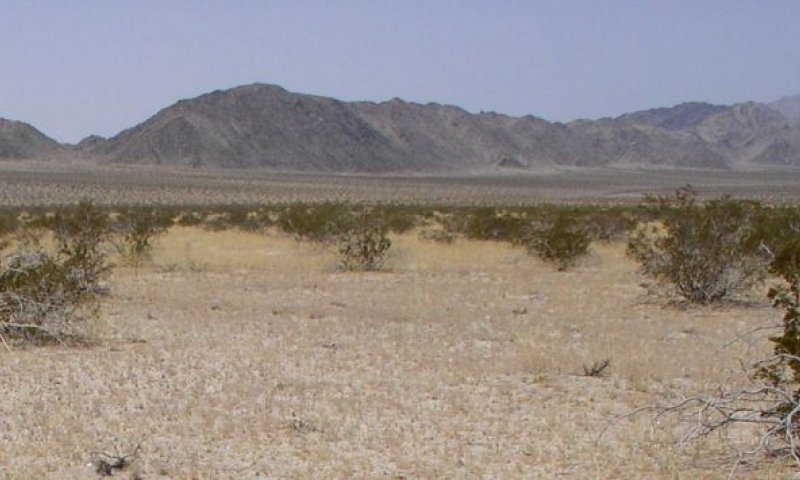

Natural Resources
Conservation Service
Ecological site R030XD025CA
Hyperthermic Sandsheets
Last updated: 10/21/2024
Accessed: 12/22/2025
General information
Provisional. A provisional ecological site description has undergone quality control and quality assurance review. It contains a working state and transition model and enough information to identify the ecological site.

Figure 1. Mapped extent
Areas shown in blue indicate the maximum mapped extent of this ecological site. Other ecological sites likely occur within the highlighted areas. It is also possible for this ecological site to occur outside of highlighted areas if detailed soil survey has not been completed or recently updated.
MLRA notes
Major Land Resource Area (MLRA): 030X–Mojave Basin and Range
MLRA Description:
Major Land Resource Area (MLRA) 30, Mojave Desert, is found in southern California, southern Nevada, the extreme southwest corner of Utah and northwestern Arizona within the Basin and Range Province of the Intermontane Plateaus. The climate of the area is hot (primarily hyperthermic and thermic; however at higher elevations, generally above 5000 feet, mesic, cryic and frigid) and dry (aridic). Elevations range from below sea level to over 12,000 feet in the higher mountain areas found within the MLRA. Due to the extreme elevational range found within this MLRA, Land Resource Units (LRUs) were designated to group the MLRA into similar land units.
LRU notes
This Land Resource Unit (designated by ‘XD’) is found on the eastern side of California. Elevations range from 400 to 2200 feet on average, but may be found up to 3600 feet on southern exposures. Precipitation ranges from 1 to 6 inches per year, but averages between 2-4 inches. This LRU is characterized primarily by the extreme aridity, hot temperatures, hyperthermic soil temperatures and low stature of widely spaced vegetation. Temperatures can reach over 110 degrees Fahrenheit for several weeks in July and August. Summer precipitation falls between July and September, ranging from 20-33% in the form of rain, and winter precipitation falls starting in November and ends between February and March, ranging from 56-70%, also mostly in the form of rain. Vegetation is primarily small, widely-spaced, low-producing creosote bush (Larrea tridentata), burrobush (Ambrosia dumosa), and brittlebush (Encelia farinosa).
Classification relationships
This ecological site is found within the Larrea tridentata Shrubland Alliance (Sawyer et al. 2009).
Ecological site concept
This ecological site is found on stabilized sandsheets and dunes at elevations ranging from 710 to 2460 feet and slopes of 0 to 8 percent. Dominant soils are very deep fine sands that formed from eolian deposits and exhibit no soil development. Soils may have an alluvial influence, but eolian processes dominate.
Hyperthermic soil temperature regimes and stable fine sands drive the vegetation dynamics of this site. Production reference value (RV) is relatively low at 140 pounds per acre, and depending on precipitation and resulting annual forb production, ranges from 40 to 270 pounds per acre. Creosote bush (Larrea tidentata) is dominant, and dyebush (Psorothamnus emoryi), and burrobush (Ambrosia dumosa) are important secondary species. Annual forbs are abundant during years of average to above average precipitation. Stable, deep fine sands with little soil development favors deep-rooted creosote bush, which accesses deep water reserves that rapidly infiltrate through deep sands. Emory’s dyebush is associated with fine sand-dominated substrates.
The data in the following sections is from major (15% of map unit or greater) components only.
Associated sites
| R030XD003CA |
Hyperthermic Steep South Slopes R030XD003CA is found on adjacent hillslopes. Brittlebush (Encelia farinosa) and creosote bush (Larrea tridentata) are dominant. |
|---|---|
| R030XD004CA |
Low-Production Hyperthermic Hills R030XD004CA is found on steep sideslopes of adjacent fan remnants. Creosote bush (Larrea tridentata) is dominant. |
| R030XD006CA |
Abandoned Fan R030XD006CA is found on adjacent fan aprons. Creosote bush (Larrea tridentata) is dominant. |
| R030XD008CA |
Hyperthermic Sandhill R030XD008CA occurs on adjacent steep sandsheets with slopes greater than 8 percent. Creosote bush (Larrea tridentata) and big galleta (Pleuraphis rigida) are dominant. |
| R030XD014CA |
Hyperthermic Sandy Plains R030XD014CA is found on adjacent less stable sandsheets. Big galleta (Pleuraphis rigida) is dominant. |
| R030XD015CA |
Hyper-Arid Fans R030XD015CA is found on adjacent alluvial fans and fan aprons. Creosote bush (Larrea tridenata) and burrobush (Ambrosia dumosa) are dominant. |
| R030XY023CA |
Hyperthermic Dissected Shallow Pediment R030XD023CA is found on adjacent pediments. Mojave indigobush (Psorothamnus arborescens) and desertsenna (Senna armata) are dominant species. |
| R030XD041CA |
Channeled Warm Alluvial Fans R030XD041CA is found on adjacent channeled fan remnants. Creosote bush (Larrea tridentata), burrobush (Ambrosia dumosa) and brittlebush (Encelia farinosa) are dominant species. |
| R030XD042CA |
Hyperthermic Shallow To Moderately Deep Fan Remnants R030XD042CA is found on adjacent fan remnants. Vegetation is very sparse and is dominated by creosote bush (Larrea tridentata). |
| R030XY001CA |
Occasionally Flooded, Hyperthermic, Diffuse Ephemeral Stream R030XY001CA is found on adjacent small, occasionally flooded ephemeral drainageways. Creosote bush (Larrea tridentata) and Schott's dalea (Psorothamnus schottii) are dominant species. |
| R030XY092NV |
DESERT PATINA This ecological site is found on adjacent fan remnants covered with desert pavement. Sparse vegetation is dominated by creosote bush (Larrea tridentata). |
Similar sites
| R030XD014CA |
Hyperthermic Sandy Plains R030XD014CA is found on less stable sandsheets with none to few rock fragments on the surface. It is a more productive site, and big galleta (Pleuraphis rigida) is dominant. |
|---|---|
| R030XD006CA |
Abandoned Fan R030XD006CA is found on fan aprons and alluvial fans. Soils do not have an eolian influence. Creosote bush (Larrea tridentata) is dominant, and big galleta (Pleuraphis rigida) is not an important species. |
| R030XD008CA |
Hyperthermic Sandhill R030XD008CA occurs on steeper sandsheets with slopes greater than 8 percent. |
| R030XD015CA |
Hyper-Arid Fans R030XD015CA occurs on alluvial fans and fan aprons. Soils do not have an eolian influence. Creosote bush (Larrea tridentata) and burrobush (Ambrosia dumosa) are dominant. |
Table 1. Dominant plant species
| Tree |
Not specified |
|---|---|
| Shrub |
(1) Larrea tridentata |
| Herbaceous |
(1) Plantago ovata |
Click on box and path labels to scroll to the respective text.



